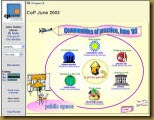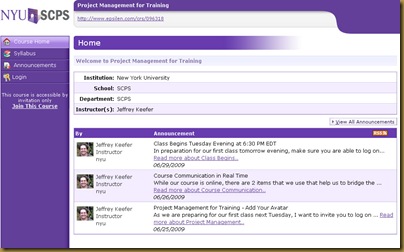I arrived a few minutes into the introductory remarks for this symposium with Matthew A. Eichler, Tani K. Bialek, Cathy Twohig, Cynthia L. Digby, Rod P. Githens, and Lynn A. Trinko. Glad I made it just in time for the introductions. Just from listening to the intros, it is clear that there is a lot of interest in this area and the attendees have had a lot of different experiences in the process.
Online discussions within class discussion boards, it can reduce some of the isolation involved in distance learning and traditional education. Online discussions have a written record of their experiences. Online discussions require a great amount of structure; “discuss this” is not sufficient. Structure questions, clear expectations, and utilize reference materials. Model a discussion posting and model how to respond with others at the beginning of a class, both to show people what to do and what you expect, as well as to help new online learners see what and how to do this. Ask people to cite who they use, even if that includes posting a link to it. Focus on active moderation, and ask people about tone and use of humor.
Form a “Coffee Shop” space in the class, to share things that may be useful but is not directly related to the work of the week. Make yourself willing to share your own experiences, especially since you expect students to do the same.
Computer-mediated communication (CMC) is electronic exchange of information with voice. There is an example of a Wimba Voice posting. I have not seen this product before, though at NYU we use Epsilen that integrates Wimba. Tani did a research project with a purely online course without a synchronous component, and there was limited student use of the voice-technology, due to fear of technology, it takes longer, background sounds, and the like. Tani created a brief eLearning session that demonstrated how to do this with voice and slides.
Cathy discussed online student services and the depth of these services compared to F2F services, and it seems this is a rich area for new research strands.
Cynthia then spoke about faculty and course programs. Really interesting statistics about how long it takes to get an online course material ready to go online (100 hours per faculty per course and 100 hours for tech support). I asked about this as an area for future research, in that universities do not compensate faculty for this extra (free) work, and students still pay the same amount for the learning (though they do not generally use the physical plant and facilities). From a critical theory perspective, I find this very troubling.
Rod is now speaking about social presence, and the emphasis on creating and supporting social presence and fostering online learning communities. The most effective place to facilitate online learning within a program is on the institutional (department) level. This helps to have a clear thread through the program and may help to build and support community. One of the challenges is for learners who prefer to have solitary learning, and this is another factor to consider with developing programs and setting expectations. At times, posting their own photos and speaking about their jobs and careers can set up a problematic status situation. Some really good questions that were raised about how online and distance education
Lynn is discussing the Community of Inquiry Model (Garrison, Anderson, and Archer, 2000), which is about the social presence, cognitive presence, and teaching presence. Teaching presence usually includes course design, discourse facilitation, and direct instruction. For the design, she suggested to storyboard and think about the layout, student navigation, think of the users / audience. She then does all the assignments along with her own students, to show the students that she is part of their group. Ouch; how does she have the time? While I think it is important to try to have as much democratic exchanges as possible, the students and the instructors really are on different levels. She also spoke about the other components of this model, and it is something I think I want to know more about. She engages the students and is online almost all the time in the class; this seems to be overly teacher-focused or otherwise too much work rather than helping to empower the students to address their own issues and support them through the process. I wonder if this is what is really happening, but just not clearly stated? She does podcasting, online office hours, Happy Friday weekly letters, instant messages, chats, etc. This seems a bit too intense for practical application, andd while I am sure this helps along her students, it also seems to somehow make them expect her to help them facilitate their issues and struggles, rather than their beginning the process and struggling (learning?) a bit on their own and with their colleaguees first.
 So, tonight begins CPsquare’s Foundations of Communities of Practice workshop. I have thought about taking this before, but neither the time nor the funding was flowing easily, so what better time than the present?!
So, tonight begins CPsquare’s Foundations of Communities of Practice workshop. I have thought about taking this before, but neither the time nor the funding was flowing easily, so what better time than the present?!